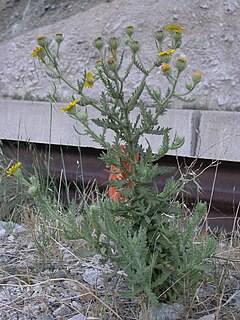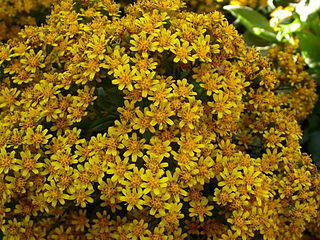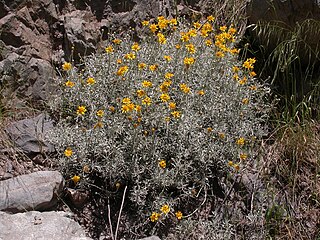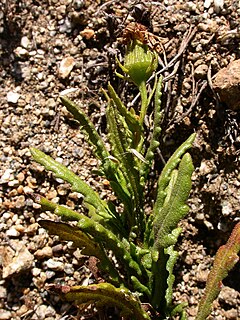
Senecio is a genus of flowering plants in the daisy family (Asteraceae) that includes ragworts and groundsels. The scientific name, Senecio, means "old man".

Senecio vulgaris, often known by the common names groundsel and old-man-in-the-spring, is a flowering plant in the daisy family Asteraceae. It is an annual herb, native to Europe and widely naturalised as a ruderal species in suitable disturbed habitats worldwide.

Senecioneae is the largest tribe of the Asteraceae, or the sunflower family, comprising about 150 genera and 3,000 species. Almost one-third of the species in this tribe are placed in the genus Senecio. Its members exhibit probably the widest possible range of form to be found in the entire plant kingdom, and include annuals, minute creeping alpines, herbaceous and evergreen perennials, shrubs, climbers, succulents, trees, and semiaquatic plants.

Río Gallegos is the capital and largest settlement of the Patagonian province of Santa Cruz in Argentina. Located in the department of Güer Aike, it has a population of about 98,000, according to the 2010 census [INDEC], a 24% increase from the 79,000 in the 2001 census [INDEC]. The city bears the name of the Gallegos River, and sits on its estuary 2,636 km (1,638 mi) south from the Argentinian federal capital Buenos Aires.

Pyrrolizidine alkaloids (PAs), sometimes referred to as necine bases, are a group of naturally occurring alkaloids based on the structure of pyrrolizidine. Pyrrolizidine alkaloids are produced by plants as a defense mechanism against insect herbivores. More than 660 PAs and PA N-oxides have been identified in over 6,000 plants, and about half of them exhibit hepatotoxicity. They are found frequently in plants in the Boraginaceae, Asteraceae, Orchidaceae and Fabaceae families; less frequently in the Convolvulaceae and Poaceae, and in at least one species in the Lamiaceae. It has been estimated that 3% of the world’s flowering plants contain pyrrolizidine alkaloids. Honey can contain pyrrolizidine alkaloids, as can grains, milk, offal and eggs. To date (2011), there is no international regulation of PAs in food, unlike those for herbs and medicines.
Quintus Sosius Senecio was a Roman senator who was favored by the emperors Domitian and Trajan. As a result of this relationship, he was twice ordinary consul, an unusual and prestigious honor: first in 99, with Aulus Cornelius Palma Frontonianus as his colleague; and again in 107 as the colleague of Lucius Licinius Sura, who was himself consul for the third time.

Brachyglottis is a genus of flowering plants in the aster family, Asteraceae. The genus was erected on November 29, 1775, by Johann Reinhold Forster and Georg Forster. The name was derived from the Greek brachus ("short") and glottis a reference to the size of the ray florets.

Erechtites is a genus of flowering plants in the daisy family known commonly as fireweeds or burnweeds. They are native to the Americas and Australia, but some species are widely distributed weeds.

Senecio adenotrichius is a species of the genus Senecio. It is native to Chile, and common on disturbed land there.

Acrisione is a genus of the tribe Senecioneae and the family Asteraceae and a native of Chile, described as a genus in 1985. There is only one known species, Acrisione denticulata.

Senecio bahioides is a flowering plant species of the genus Senecio and family Asteraceae. It is a native of Chile.

Senecio chilensis is a species of the genus Senecio, family Asteraceae and one of the many species of Senecio native to Chile.

Senecio coquimbensis is a species of the genus Senecio, family Asteraceae and one of the many species of Senecio native to Chile.

Senecio cerberoanus is a species of the genus Senecio, family Asteraceae and one of the many species of Senecio native to Chile.

Senecio fistulosus is a species of the genus Senecio, family Asteraceae and one of the many species of Senecio native to Chile.

Senecio haloragis is a species of the genus Senecio and family Asteraceae and a native of Chile.

Senecio tripinnatifidus is a species of the genus Senecio and family Asteraceae and is a native of Chile.

Senecio planiflorus is a species of the genus Senecio and family Asteraceae. It is endemic to Chile.

Senecio antofagastanus is a species of flowering plant in the family Asteraceae. It is endemic to Chile.


















